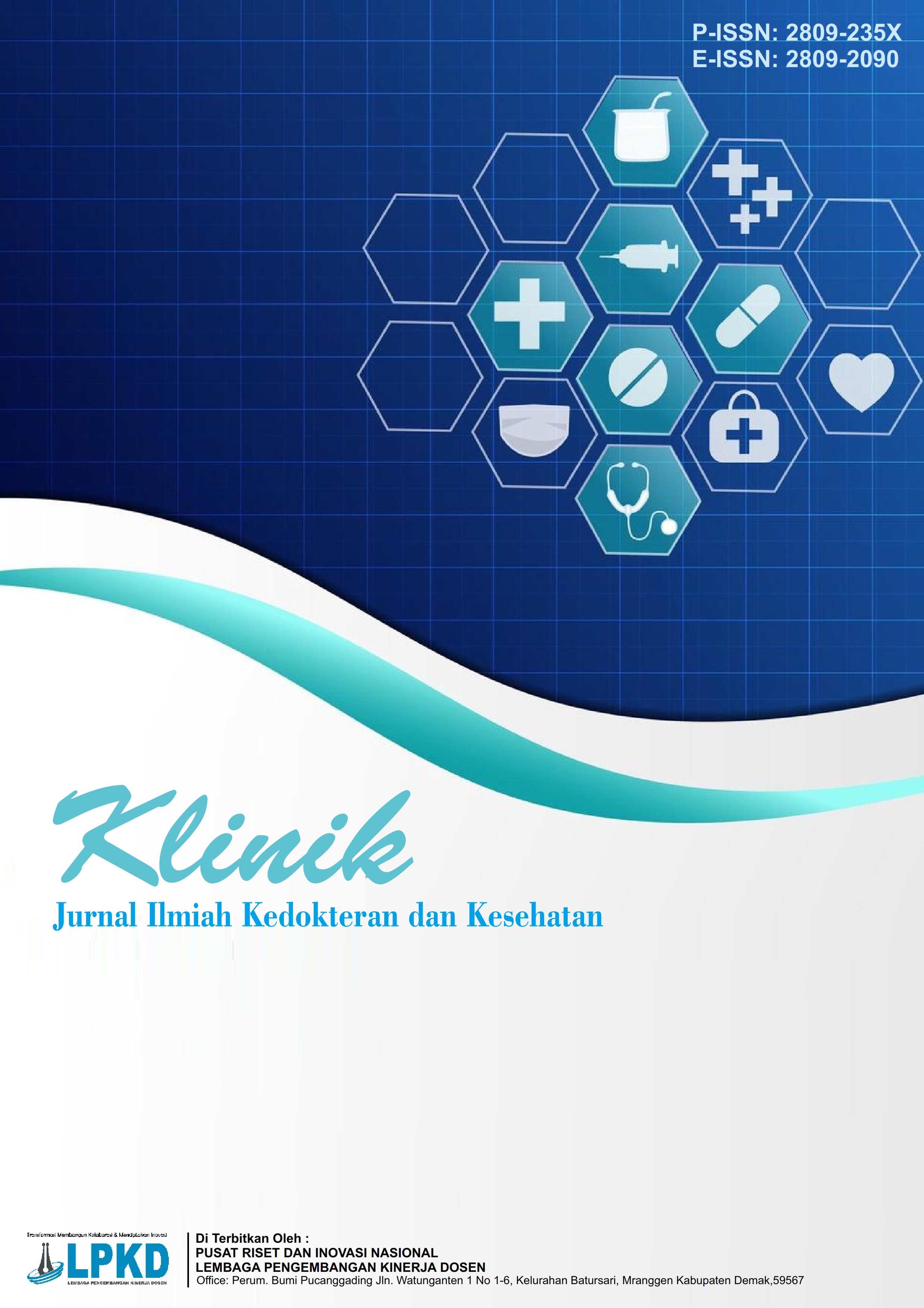Analisis Efektivitas Rekam Medis Elektronik Berdasarkan Mutu Rekam Medis di Rawat Inap Rumah Sakit Patria IKKT
DOI:
https://doi.org/10.55606/klinik.v5i1.5467Keywords:
Doctor Verification, Electronic Medical Records, Inpatient, Medical Record Quality, Verification ComplianceAbstract
This study analyzes the effectiveness of electronic medical records (EMR) based on the quality of medical records in inpatient services at Patria IKKT Hospital. The aim of this study is to evaluate the completeness of data entry, accuracy, timeliness, and compliance in the verification process by the responsible doctor (DPJP). The research method used is retrospective analysis with a cross-sectional approach, conducted in January 2025. The study involves a total sample of inpatient patient medical records recorded in the EMR system. The results indicate that although the EMR has been implemented, several issues related to data completeness and accuracy, as well as the timeliness of verification by DPJP, were identified. Additionally, compliance with verification procedures was found to vary among healthcare providers. This evaluation provides an overview of the effectiveness of EMR usage in supporting service quality at Patria IKKT Hospital, with recommendations to enhance training and standard operating procedures (SOP) related to data entry and verification. Implementing a more consistent EMR usage compliance program could help improve the quality of medical records and inpatient service quality at this hospital.
References
Aldosari, B. (2017). Causes of EHR projects stalling or failing: A study of EHR project in Saudi Arabia. Computers in Biology and Medicine, 91, 372–381. https://doi.org/10.1016/j.compbiomed.2017.10.032
Ammenwerth, E., Schnell-Inderst, P., & Machan, C. (2008). The effect of electronic prescribing on medication error and adverse drug events: A systematic review. Journal of the American Medical Informatics Association, 15(5), 585–600. https://doi.org/10.1197/jamia.M2667
Brundin, R., & Soo, A. (2013). An electronic medical records system for clinical research and the EMR-EDC interface. Journal of Critical Care, 47, 295–301. https://doi.org/10.1016/j.jcrc.2018.07.021
Brundin, R., Soo, A., & Zuege, D. (2018). Secondary EMR data for quality improvement and research: A comparison of manual and electronic data collection from an integrated critical care electronic medical record system. Journal of Critical Care, 47, 295–301. https://doi.org/10.1016/j.jcrc.2018.07.021
Cheshire, W. (2014). Can electronic medical records make physicians more ethical? The Linacre Quarterly, 30(3), 255–262.
Clara, et al. (2018). How do paper and electronic records compare for completeness? A three-centre study.
Donabedian, A. (2003). An introduction to quality assurance in health care. Oxford University Press. https://doi.org/10.1093/oso/9780195158090.002.0006
Erawantini, F. (2013). Rekam medik elektronik: Telaah manfaat dalam konteks pelayanan kesehatan dasar. Fakultas Kedokteran Universitas Gadjah Mada.
Gunarti, R. (2019). Manajemen rekam medis di layanan kesehatan. Thema Publishing.
Hatta, G. (2017). Pedoman manajemen informasi kesehatan di sarana pelayanan kesehatan. Penerbit Universitas Indonesia.
Hong, C. J., & Kaur, M. N. (2015). Accuracy and completeness of electronic medical records obtained from referring physicians in a Hamilton, Ontario, plastic surgery practice: A prospective feasibility study. Canadian Journal of Plastic Surgery, 23(1), 56–60. https://doi.org/10.4172/plastic-surgery.1000900
Indar, I. (2013). Faktor yang berhubungan dengan kelengkapan rekam medis di RSUD H. Padjonga DG. Ngalle Takalar. Universitas Hasanuddin.
Jawhari, B., Ludwick, D., Keenan, L., et al. (2016). Benefits and challenges of EMR implementations in low-resource settings: A state-of-the-art review. BMC Medical Informatics and Decision Making, 16(116). https://doi.org/10.1186/s12911-016-0354-8
Jeffrey, J. (2013). Assessment of the impact on time to complete medical record using an electronic medical record versus a paper record on emergency department patients: A study.
Kementerian Kesehatan Republik Indonesia. (2008). Keputusan Menteri Kesehatan Nomor 128 Tahun 2008 tentang Standar Pelayanan Minimal Rumah Sakit.
Kementerian Kesehatan Republik Indonesia. (2010). Keputusan Menteri Kesehatan Nomor 1778 Tahun 2010 tentang Pedoman Penyelenggaraan Pelayanan Intensive Care Unit (ICU) di Rumah Sakit.
Kementerian Kesehatan Republik Indonesia. (2013). Peraturan Menteri Kesehatan Nomor 55 Tahun 2013 tentang Penyelenggaraan Pekerjaan Rekam Medis.
Kementerian Pendayagunaan Aparatur Negara Republik Indonesia. (2002). Surat Keputusan Menteri Pendayagunaan Aparatur Negara Nomor 135 Tahun 2002 tentang Jabatan Fungsional Perekam Medik dan Angka Kreditnya.
Köpcke, F., & Trinczek, B. (2013). Evaluation of data completeness in the electronic health record for the purpose of patient recruitment into clinical trials: A retrospective analysis of element presence. BMC Medical Informatics and Decision Making, 13(37). https://doi.org/10.1186/1472-6947-13-37
Koppel, R., & Majumdar, S. (2015). Electronic health records and quality of diabetes care. New England Journal of Medicine, 365, 825–827.
Laxmisan, A., & Sittig, D. (2012). Effectiveness of an electronic health record-based intervention to improve follow-up of abnormal pathology results: A retrospective record analysis. Medical Care, 50(10), 898–904. https://doi.org/10.1097/MLR.0b013e31825f6619
Paterick, Z., & Patel, N. (2018). Medical liability in the electronic medical records era. Baylor University Medical Center Proceedings, 31(4), 558–561. https://doi.org/10.1080/08998280.2018.1471899
Perry, J., Sutherland, J., & Symington, C., et al. (2013). Assessment of the impact on time to complete medical record using an electronic medical record versus a paper record on emergency department patients: A study. BMJ, 31, 980–985. https://doi.org/10.1136/emermed-2013-202479
Porterfield, A., & Angelberd, K. (2014). Electronic prescribing: Improving the efficiency and accuracy of prescribing in the ambulatory care setting.
Rini, M., Jak, Y., & Wiyono, T. (2019). Analisis kelengkapan pengisian rawat inap kebidanan RSIA Bunda Aliyah Jakarta tahun 2019. Universitas Respati Indonesia.
Sevick, L., & Esmail, R. (2017). A systematic review of the cost and cost-effectiveness of electronic discharge communications. BMJ Open, 7(e014722). https://doi.org/10.1136/bmjopen-2016-014722
Shahmoradi, L., & Darrudi, A. (2017). Electronic health record implementation: A SWOT analysis.
Shawahna, R., & Rahman, N. (2014). Electronic prescribing reduces prescribing errors in public hospital.
Thielst, C. B. (2007). The evolution of the electronic health record. Health Administration Press.
Velthoven, M., Mastellos, N., Majeed, A., et al. (2016). Feasibility of extracting data from electronic medical records for research: An international comparative study. BMC Medical Informatics and Decision Making, 16(90). https://doi.org/10.1186/s12911-016-0332-1
Weiskopf, N., & Hripcsak, G. (2014). Defining and measuring completeness of electronic health records for secondary use. Journal of Biomedical Informatics, 46(5), 830–841. https://doi.org/10.1016/j.jbi.2013.06.010
Zheng, H., & Gaff, H. (2014). Epidemic surveillance using an electronic medical record: An empiric approach to performance improvement. PLoS ONE, 9(7), e100845. https://doi.org/10.1371/journal.pone.0100845
Downloads
Published
How to Cite
Issue
Section
License
Copyright (c) 2025 Jurnal Ilmiah Kedokteran dan Kesehatan

This work is licensed under a Creative Commons Attribution-ShareAlike 4.0 International License.








